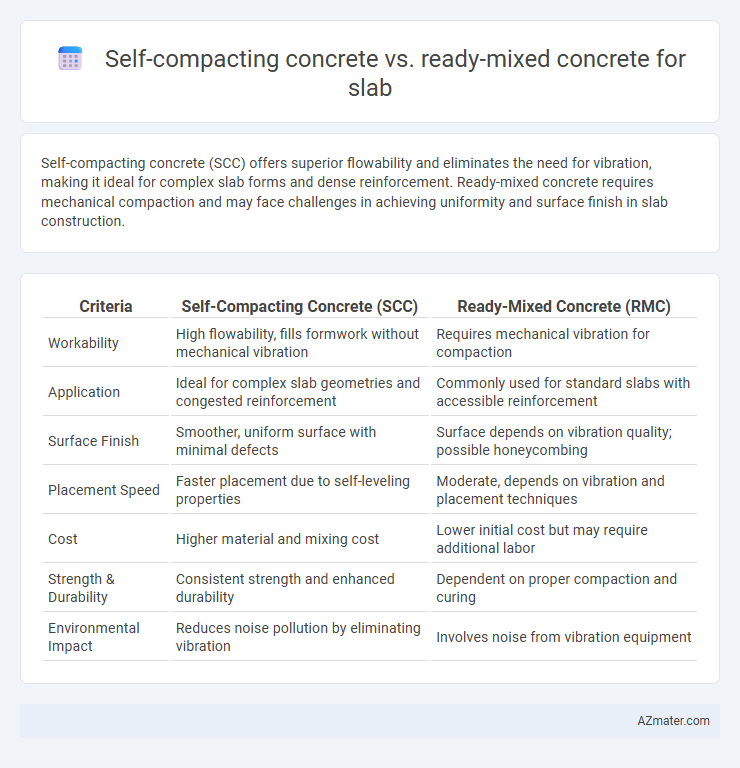Self-compacting concrete (SCC) offers superior flowability and eliminates the need for vibration, making it ideal for complex slab forms and dense reinforcement. Ready-mixed concrete requires mechanical compaction and may face challenges in achieving uniformity and surface finish in slab construction.
Table of Comparison
| Criteria | Self-Compacting Concrete (SCC) | Ready-Mixed Concrete (RMC) |
|---|---|---|
| Workability | High flowability, fills formwork without mechanical vibration | Requires mechanical vibration for compaction |
| Application | Ideal for complex slab geometries and congested reinforcement | Commonly used for standard slabs with accessible reinforcement |
| Surface Finish | Smoother, uniform surface with minimal defects | Surface depends on vibration quality; possible honeycombing |
| Placement Speed | Faster placement due to self-leveling properties | Moderate, depends on vibration and placement techniques |
| Cost | Higher material and mixing cost | Lower initial cost but may require additional labor |
| Strength & Durability | Consistent strength and enhanced durability | Dependent on proper compaction and curing |
| Environmental Impact | Reduces noise pollution by eliminating vibration | Involves noise from vibration equipment |
Introduction to Self-Compacting Concrete and Ready-Mixed Concrete
Self-compacting concrete (SCC) is engineered for high flowability and self-leveling properties without the need for mechanical vibration, ideal for complex slab molds and congested reinforcement areas. Ready-mixed concrete (RMC) is a conventional mixture prepared in batching plants and transported to construction sites, offering consistency and convenience but requiring vibration for proper placement in slabs. SCC enhances slab quality with reduced labor and faster construction times, while RMC remains widely used for its versatility and cost-effectiveness.
Composition and Material Properties Comparison
Self-compacting concrete (SCC) for slabs features a high powder content, typically 400-600 kg/m3 of cementitious materials including supplementary cementitious materials like fly ash or slag, combined with superplasticizers to enhance flowability without segregation. Ready-mixed concrete (RMC) generally contains lower cement content, around 300-450 kg/m3, with conventional aggregates and water-cement ratios designed for standard workability but requires mechanical compaction. SCC exhibits superior rheological properties, high flowability, and improved surface finish, whereas RMC offers conventional strength and durability but relies on vibration for proper consolidation and uniformity.
Workability and Placement Efficiency
Self-compacting concrete (SCC) offers superior workability compared to ready-mixed concrete (RMC), flowing easily into complex slab forms without the need for vibration, which enhances placement efficiency and reduces labor costs. SCC's high fluidity minimizes segregation and ensures uniform compaction, making it ideal for tight reinforcement and intricate geometries in slab construction. Ready-mixed concrete requires mechanical consolidation to achieve comparable density, potentially slowing placement and increasing time on site.
Surface Finish Quality and Consistency
Self-compacting concrete (SCC) offers superior surface finish quality for slabs due to its high fluidity, allowing it to fill formwork without vibration, resulting in smooth, uniform surfaces with minimal honeycombing or voids. In contrast, ready-mixed concrete requires mechanical vibration to achieve proper compaction, leading to potential variability in surface consistency and increased risk of surface defects. The inherent uniformity of SCC enhances consistency in slab finishes, making it ideal for architectural applications demanding high aesthetic standards.
Structural Performance and Durability
Self-compacting concrete (SCC) offers superior structural performance for slabs due to its high flowability and uniform compaction, reducing voids and enhancing load distribution compared to ready-mixed concrete. SCC's enhanced durability stems from its dense microstructure, which improves resistance to cracking, permeability, and environmental degradation. Ready-mixed concrete requires mechanical vibration to achieve compaction, which can lead to inconsistent density and potential weak points in slab performance over time.
Labor and Equipment Requirements
Self-compacting concrete (SCC) reduces labor requirements on slab projects by eliminating the need for extensive vibration, allowing for faster placement and finishing. Ready-mixed concrete (RMC) requires skilled workers and vibrators to ensure proper compaction and avoid honeycombing, increasing labor intensity. Equipment needs for SCC include pumps capable of handling high flowability, while RMC relies on conventional mixers and vibrators, impacting project timelines and costs.
Time Savings during Construction
Self-compacting concrete (SCC) significantly reduces labor and formwork requirements by flowing effortlessly into complex mold shapes, accelerating slab construction compared to ready-mixed concrete (RMC), which necessitates vibration and manual compaction. The elimination of mechanical consolidation in SCC shortens setting times and improves surface finish, enabling faster curing and early removal of formwork, thus saving valuable project time. In contrast, RMC slabs often require additional time for vibration and quality checks, extending overall construction schedules.
Cost Analysis: Initial and Long-term Considerations
Self-compacting concrete (SCC) typically incurs higher initial costs than ready-mixed concrete (RMC) due to specialized admixtures and precise mix designs, yet it reduces labor and formwork expenses by eliminating the need for vibration. Long-term, SCC offers cost savings through enhanced durability and reduced maintenance, making it economically advantageous for slab applications subjected to heavy loads or aggressive environments. In contrast, RMC remains cost-effective for standard slabs with simpler placement requirements but may lead to higher lifecycle costs due to potential defects and repairs.
Environmental Impact and Sustainability
Self-compacting concrete (SCC) reduces environmental impact by minimizing waste and energy consumption due to its enhanced flowability, which eliminates the need for vibration equipment and lowers noise pollution on-site. Ready-mixed concrete (RMC) offers controlled mixing at centralized plants, potentially reducing raw material waste and transportation emissions through optimized batching and logistics. SCC's ability to incorporate supplementary cementitious materials, such as fly ash and slag, further enhances its sustainability compared to conventional RMC for slab applications.
Best Applications and Recommendations for Slab Construction
Self-compacting concrete (SCC) offers superior flowability and eliminates the need for mechanical compaction, making it ideal for slabs with complex reinforcement or congested formwork in high-performance construction projects. Ready-mixed concrete is suitable for straightforward slab applications where ease of placement and cost-efficiency are priorities, provided proper vibration ensures adequate compaction and durability. For slab construction, SCC is recommended in scenarios demanding high surface finish quality and reduced labor, while ready-mixed concrete remains a reliable choice for standard slabs with simpler formwork configurations.

Infographic: Self-compacting concrete vs Ready-mixed concrete for Slab
 azmater.com
azmater.com